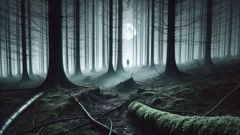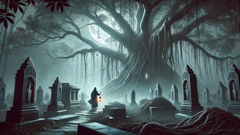Introduction
The forests of northern Sweden hold secrets in their silence. Between the ancient pines and tangled undergrowth, where mist rises from peat-rich earth and the sun lingers only briefly in winter, shadows move with a purpose older than memory. Villages here are small—clusters of red-painted cottages clinging to clearings in the forest. Life in the 19th century is marked by hard work and harder winters. The people of Västerbotten, like their ancestors, keep to the old ways: tending their herds, mending nets, praying for good harvests, and whispering of spirits that wander the night. Among these tales, none is as chilling or sorrowful as that of the Myling—the restless ghosts of children denied baptism, doomed to haunt the places where they perished. It is said their cries pierce the stillness just before dawn, pleading to be carried to consecrated ground. Some villagers claim to have heard small, cold hands scratching at their doors. Others refuse to speak of such things at all, as if silence might ward off the supernatural. But for those who have known loss, the legend lingers at the edge of every shadow. One autumn, as the first frost dusts the moss and the lake steams beneath a pale sky, a grieving mother named Ingrid finds herself at the heart of this enduring myth. Her sorrow—raw and unspoken—ripples through her home, through her marriage, through the forest itself. The villagers avert their gaze; they sense something is not right. They know that when a child dies unbaptized, the earth remembers. And the dead, denied rest, may seek a kindness the living cannot easily grant. In such a place, in such a time, fear and hope become tangled roots, and every cold gust carries with it the possibility of encountering the unknown. This is the story of the Myling—a legend that is, at its core, a lament for what is lost, and a search for peace amid relentless grief.
I. The Cry in the Night
Night in Västerbotten comes quickly in autumn. The days shrink until they are little more than blue-tinged sighs between dusk and darkness. Ingrid sat by the window, her hands twisting a ragged handkerchief. Her cottage, neat and sturdy, was quiet—too quiet since she’d buried her baby a month before. The child’s cradle stood in the corner, untouched, the little knitted blanket folded with care that broke her heart anew each morning. Her husband, Anders, worked later in the woods these days, his grief driving him to long hours with axe and saw. Their words had dwindled to grunts and sighs. Ingrid’s own mother had tried to comfort her, bringing soup and admonitions to pray, but the emptiness in Ingrid’s arms was a wound that no words could heal.
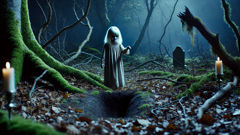
Outside, the wind rattled the shutters and scattered pine needles across the garden. Ingrid shivered, standing to feed the fire, when she heard it—a cry, thin as spider silk but unmistakable. It came again, rising above the wind, then fading as if swallowed by the trees. Her blood ran cold. The stories came back to her: the Myling, small ghosts with voices like lost birds. She hurried to the door, heart pounding.
The village lay hushed beneath the northern stars. The moon was bright, making each branch and stone a sharp black shadow. The lake beyond the fields steamed, its surface ghostly under the sky. Ingrid stepped out, wrapped in her shawl, trying to convince herself it was only a fox or a nightjar. But the sound had pierced her in a way she couldn’t ignore. With trembling steps, she walked to the edge of the forest. The trees seemed to lean in, their trunks crowding together as if to bar her path. Again came the cry—closer now, plaintive and urgent. She called out, her voice breaking.
“Inga? Is that you, little one?”
Silence answered. Then—a rustle, a flash of white behind a stump. She felt the cold seep through her shoes and up her legs. Her mind warred between terror and longing; every tale she’d ever heard of the Myling pressed against her reason. The priest had warned them: unbaptized children could not rest. Ingrid’s daughter, born too soon, had never been christened. The thought twisted inside her.
She pressed deeper into the woods, guided by the moon and the memory of her child’s tiny hands. The cry came again, and this time it was unmistakably a child’s voice—her child’s, she was certain. Branches caught at her shawl, roots tangled her steps. She stumbled, weeping, but pressed on. At the heart of the thicket, she found a clearing where the ground sloped down to a hollow choked with moss and fallen leaves. There, in the cold blue glow, stood a figure—small, thin, with hair like flax and eyes that seemed to shine.
“Inga?” she whispered.
The child looked up. For a moment, Ingrid saw only her daughter—perfect, alive, and smiling. Then the image wavered; the child’s skin was too pale, her mouth too still. The air grew colder. Ingrid sank to her knees, arms open. The Myling stared, silent now, then raised one tiny hand and pointed to the earth at her feet.
A chill realization crept over Ingrid. The stories were true: Myling sought only one thing—a proper resting place, a burial in hallowed ground. Tears streaked Ingrid’s face. She’d been too ill after the birth, too weak to walk to the churchyard. Anders had buried the baby at the forest’s edge instead, promising to move her later. But later had never come. The Myling’s gaze bored into Ingrid. Shame and love warred in her heart. She gathered the small figure in her arms, cold as winter water. “I’ll carry you,” she whispered, voice shaking. “I promise.”
II. The Weight of Sorrow
Ingrid’s arms ached with the chill of carrying her Myling child. Though the figure was small, the burden grew heavier with each step toward home. It felt as if every sorrow she had ever known pressed down upon her shoulders: the silent meals, Anders’s withdrawn grief, the villagers’ pitying glances. The Myling clung to her, face hidden in Ingrid’s shawl, not making a sound but radiating a longing that was almost physical.
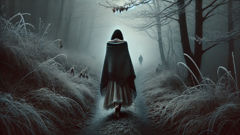
The path twisted through thickets where frost already rimed the ferns and the ground was soft from autumn rain. Ingrid stumbled more than once. Each time she nearly fell, the Myling’s weight seemed to double. She recalled the old women’s warnings: the longer a Myling is denied rest, the heavier it becomes, until the living can bear it no longer. Some stories ended with travelers crushed beneath their spectral burdens, never making it to consecrated earth.
Ingrid gritted her teeth. She would not fail her child again. The forest pressed close around her, every shadow seeming to whisper, every creak and sigh of the pines reminding her of all she’d lost. The Myling did not speak, but Ingrid’s mind filled with memories: the tiny hands that had once grasped her finger, the soft breath against her neck. She thought of Anders, his face lined with sorrow, and wondered if he too felt this weight—the knowledge of a promise unkept.
When she finally reached her cottage, the fire had burned low. The Myling vanished from her arms as she crossed the threshold, leaving only a chill in the air and a single, damp footprint on the wooden floor. Ingrid sat by the fire, staring at the cradle. She resolved then: she would bring her daughter to the churchyard, no matter what it cost.
Word spread quickly in small villages. The next morning, as mist curled over the fields and crows cawed from the treetops, Ingrid approached the priest’s house. He was a stern man with a thin mouth and sharp eyes, but even he softened at the sight of her. She told him everything—the birth, the fever, the hurried burial at the forest’s edge. She confessed her fears about the Myling, voice trembling. The priest listened in silence, his face unreadable. When she finished, he sighed and agreed to help, though he warned her that exhuming the dead—especially a child—was not a thing to be done lightly.
That afternoon, Anders joined them at the forest’s edge. His hands shook as he dug, but his movements were careful, reverent. Ingrid wept quietly as they lifted the tiny bundle from the earth, her child’s face as peaceful as if sleeping. The priest intoned solemn prayers, blessing the ground and the child before them. Together, they carried the small coffin down the muddy path toward the churchyard, every step heavy with grief and hope.
III. The Churchyard and the Restless Dead
The church in Västerbotten stood on a low hill overlooking the lake, its whitewashed walls and slate roof visible from every field and farm for miles around. The graveyard encircled it like a ring of sorrow and remembrance—old stones tilted by time, crosses made from birch wood, and patches of wildflowers growing among the grass. As Ingrid, Anders, and the priest approached, villagers gathered at a distance. Some watched in silence, others crossed themselves or whispered prayers for mercy. The legend of the Myling was known to all, but few had ever seen it confronted so openly.
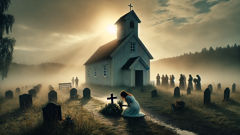
The burial was simple. The priest spoke of grace, of forgiveness, and of the love that binds even after death. Ingrid knelt by the tiny grave, pressing her palm to the earth as if to reassure her child that she was not alone. Anders stood beside her, his face wet with tears. As the last clods of soil fell and the prayers ended, the sun broke through clouds, casting a brief golden light over the churchyard. For a moment, the world seemed to pause—a hush deeper than any silence Ingrid had ever known.
That night, Ingrid lay awake, listening for the cry that had haunted her for weeks. The forest beyond her window was still. No wind rattled the shutters, no shadows flickered beneath the pines. She dreamed of her daughter—not as a ghost, but as a laughing child running through fields of wildflowers, her cheeks flushed with life. When she awoke, her heart felt lighter.
But the village did not forget so easily. For generations, parents had told their children to stay away from the woods at night, warning them of the Myling’s hunger for rest. Some believed that burying an unbaptized child in church ground would anger the spirits; others saw Ingrid’s courage as a blessing, a sign that love could break even the oldest curses. There were still those who claimed to hear weeping in the dark—soft voices drifting through mist and pine—but now those stories were tinged with hope rather than dread.
Ingrid tended her daughter’s grave every Sunday. She brought wildflowers and sang lullabies. Sometimes, she thought she saw a pale shape at the edge of the trees—a glimpse of flaxen hair, a hand waving farewell. But she no longer feared the Myling. She knew her child had found peace, and that love endures even when all else is lost.
Conclusion
Stories like that of the Myling endure because they speak to our deepest fears and hopes. In every corner of Sweden’s ancient forests, in every churchyard touched by sorrow, the legend whispers of the bonds between the living and the dead. For Ingrid and her family, love proved stronger than grief, guiding them through darkness toward a fragile peace. The village learned to see not just curses in the night, but also the possibility of redemption—the idea that even those lost and forgotten can be brought home again. As years passed, Ingrid’s tale became part of the region’s folklore, told beside winter fires and passed from mother to daughter. The Myling remained a warning, yes, but also a testament: that compassion can outlast fear, that remembrance can bring healing, and that every soul deserves rest. In the hush between trees, when mist curls on the ground and the moon is high, some say you can still hear a lullaby—soft and hopeful—floating on the northern wind.

